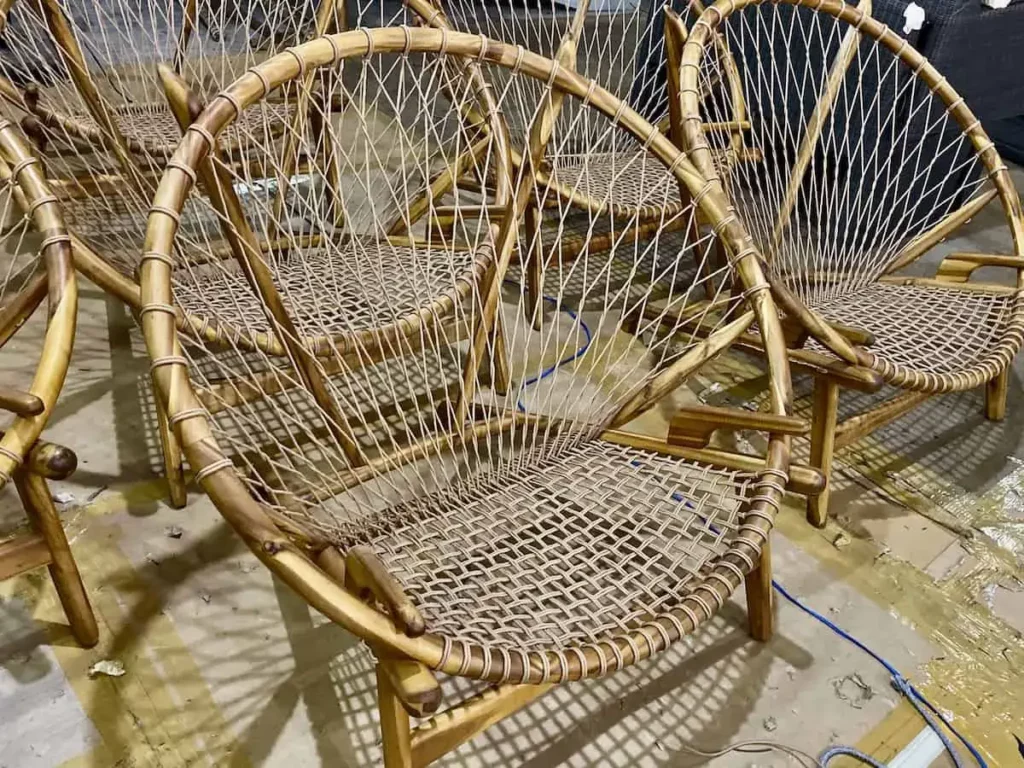Outdoor furniture has to withstand diverse weather conditions, making the choice of material critical. With its timeless appeal, wood is an evergreen favorite for outdoor furniture.
Not all wood types are equally adept at braving the elements, so when choosing woods for your outdoor furniture, you must understand the best woods. Read on as we will explore some of the best woods for outdoor furniture, including teak, acacia, eucalyptus, iroko (also known as African teak), oak, and cedar. We will delve into their pros and cons, helping you select the most suitable choice for your outdoor living space.
Table of Contents
- Our 6 Best Choices Of Outdoor Wood For Your Outdoor Furniture
- Making A Choice: Factors To Consider For Outdoor Furniture Wood Choices
- Related Content
Our 6 Best Choices Of Outdoor Wood For Your Outdoor Furniture
The decision to select the suitable material for outdoor furniture is crucial, given the weather conditions it must endure. With its eternal charm, wood consistently ranks as a top pick for outdoor furniture.
However, not every type of wood can confront and withstand the elements with the same tenacity.
Read on as we will investigate some of the most suitable types of wood for outdoor furniture, namely teak, acacia, eucalyptus, iroko (often referred to as African teak), oak, and cedar. We will navigate through the advantages and drawbacks of each, aiming to guide you toward the perfect choice for your outdoor sanctuary.
1. Teak Wood For Outdoor Furniture

Teak is one of the most popular woods for outdoor furniture, prized for its exceptional durability and water resistance. It is native to South and Southeast Asia and has a rich, golden brown color.

Pros of Teak Wood:
Teak’s high oil content makes it naturally resistant to rot, insects, and the effects of sun, rain, frost, and snow. It doesn’t warp, crack, or become brittle, which ensures long-lasting furniture. Its luxurious look and minimal maintenance requirements further enhance its appeal.
Cons of Teak Wood:
The downside of teak is its price. High demand and limited supply make it one of the most expensive options for outdoor furniture. Additionally, it’s pretty heavy, which could be a disadvantage if you often rearrange your outdoor setting.

2. Acacia Wood For Outdoor Furniture

Acacia is a dense, durable hardwood that can rival the quality of teak. It originates mainly from Australia but is also found in Asia, Africa, and the Americas.
Pros of Acacia Wood:
Acacia is weather-resistant, complex, and robust, making it an excellent choice for outdoor furniture. Its beautiful grain patterns and rich colors ranging from warm amber to dark mahogany, add to its appeal.
Cons of Acacia Wood:
Acacia requires regular maintenance to keep its looks and durability. It may crack and lose color if not correctly sealed and oiled.
3. Eucalyptus Wood For Outdoor Furniture

Eucalyptus is a fast-growing hardwood known for its robustness and eco-friendliness. It’s native to Australia but has been introduced to other parts of the world.
Pros of Eucalyptus Wood:
Eucalyptus wood is dense, durable, and naturally resistant to rot and insects. It is less expensive than teak, making it a cost-effective choice. Being a fast-growing species, it’s also more sustainable.
Cons of Eucalyptus Wood:
Despite its natural durability, eucalyptus requires routine maintenance to prevent cracking and fading. It’s also relatively heavy, which might limit mobility.
4. Iroko (African Teak) For Outdoor Furniture

Iroko is a large hardwood from the west coast of tropical Africa. It is often called African Teak due to its similar properties and appearance.
Pros for Iroko Wood:
Iroko shares teak’s resistance to decay, insects, and weather conditions. Its durability and attractive grain make it an excellent choice for outdoor furniture.
Cons For Iroko Wood:
Iroko wood is a relatively expensive option, and its sourcing can raise sustainability concerns. Like teak, it is also quite heavy.
5. Oak For Outdoor Furniture
Oak is a classic choice for furniture, known for its strength and attractive grain. Two types commonly used are red oak and white oak, the latter being more weather-resistant.

Pros For Oak:
Oak is strong, durable, and less prone to warping or cracking. It can be stained or painted in various colors, allowing customization to suit your outdoor decor.
Cons For Oak:
Oak is less resistant to rot and insects than other woods on this list. It requires a good finish and regular maintenance to keep it in prime condition when used outdoors.
6. Cedar For Outdoor Furniture
Cedar, notably Western Red Cedar, is commonly used for outdoor furniture because of its superior weather resistance and distinctive aroma.

Pros For Cedar Wood:
Cedar wood is lightweight yet sturdy, making it easy to rearrange without compromising durability. Its resistance to decay and insect damage is impressive, and the rich, warm colors range from light amber to deep honey brown. Moreover, its characteristic aroma is a natural insect repellent.
Cons For Cedar Wood:
While cedar holds up well in rainy climates, it is less resistant to harsh sunlight. Over time, it can fade and dry out if exposed to intense sun. Regular treatment with a UV-blocking finish can prevent this, but it does add to the maintenance.
Making A Choice: Factors To Consider For Outdoor Furniture Wood Choices
Choosing the best wood for outdoor furniture depends on several factors. Consider the climate in your region, the degree of maintenance you are prepared to undertake, and of course, your budget.
For damp climates, cedar is a standout choice due to its superior resistance to rot. If you live in an area with intense sunlight, consider teak or iroko, both highly resistant to UV rays.
Teak is an unrivaled choice for those who invest in high-end outdoor furniture that demands minimal maintenance. Acacia and eucalyptus provide a balance of affordability and durability, while oak offers the appeal of classic elegance, albeit with more upkeep requirements.
Sustainability is another crucial factor. Look for woods sourced from responsibly managed forests. Fast-growing species like acacia and eucalyptus are generally more sustainable than slow-growing ones like teak and oak.
Outdoor wooden furniture can bring warmth, style, and comfort to any outdoor living space. Each type of wood has unique strengths and weaknesses, but with adequate care and maintenance, they can all serve you well.
Whether you opt for the luxury of teak or the affordability of acacia, the choice ultimately depends on your preference and specific needs. Hopefully, this guide has shed some light on the best woods for outdoor furniture, making your decision a bit easier. Happy decorating!
Find out more about how Mondoro can help you create, develop, and manufacture excellent home decor and furniture products – don’t hesitate to contact me, Anita. Check out my email by clicking here or become a part of our community and join our newsletter by clicking here.
Mondoro gives out a FREE Lookbook to anyone interested. You can receive a copy of our latest Lookbook by clicking here.
Listen to our Podcast called Global Trade Gal. You can find it on all major podcast platforms. Try out listening to one of our podcasts by clicking here.
Subscribe to our Mondoro Company Limited YouTube Channel with great videos and information by clicking here.
Related Content
Is Teak a Coniferous, Evergreen, or Deciduous Tree? 11 Teak Wood Facts
Teak is a deciduous, not evergreen or coniferous tree. Teak leaves do not fall off in the wintertime but in the dry season; in Asia, where teak trees are naturally grown, the dry season is not always the same as winter. As the teak leaves do fall off, the tree is considered to be a deciduous tree.
You can learn more by reading our blog, Is Teak a Coniferous, Evergreen, or Deciduous Tree? 11 Teak Wood Facts, by clicking here.
Why Is Cherry Wood Furniture So Expensive?
Cherrywood is a wood found to be harvested in America and Europe. There are many reasons why Cherrywood is expensive when used on furniture pieces, but the price will also depend upon what kind of wood is used.
You can learn more by reading our blog, Why Is Cherry Wood Furniture So Expensive? by clicking here.
What Are The Types Of Wood Used In Furniture?
Wood for furniture is divided up into complex and softwood. Though the woods have some similarities, they also have some differences. Different looks and types of furniture may require a certain kind of wood. Some wood species will be higher priced, and others will be cheaper; price, durability, look, color, finish, and structure can decide what wood to choose for your furniture piece.
You can learn more by reading What Are The Types Of Wood Used In Furniture? by clicking here.


